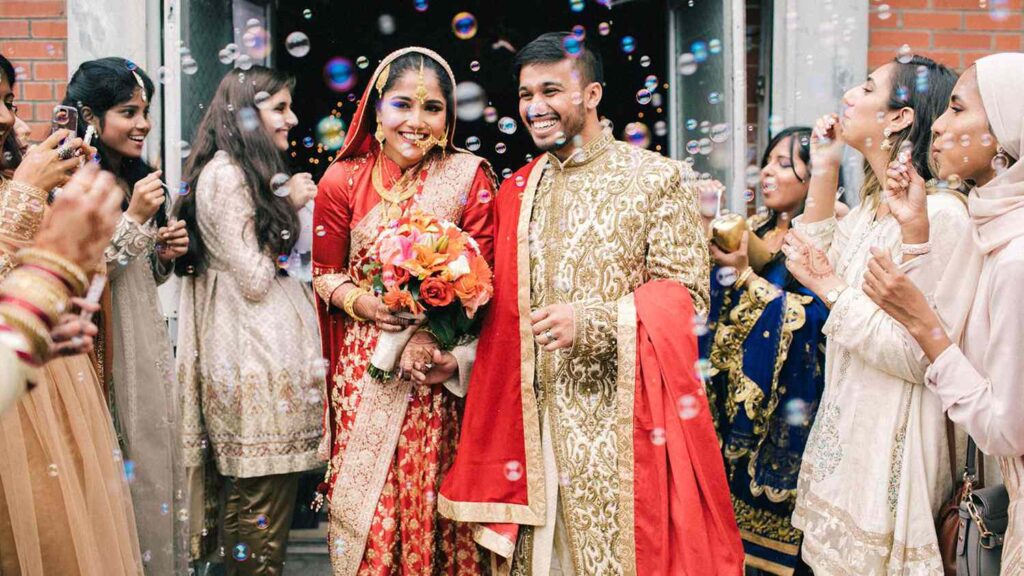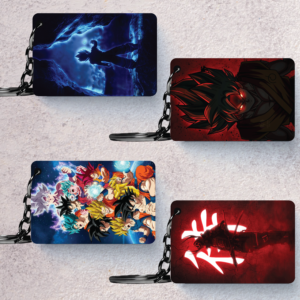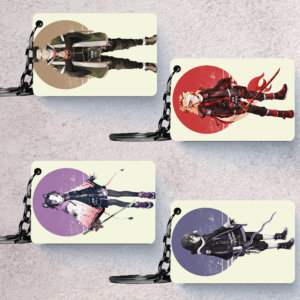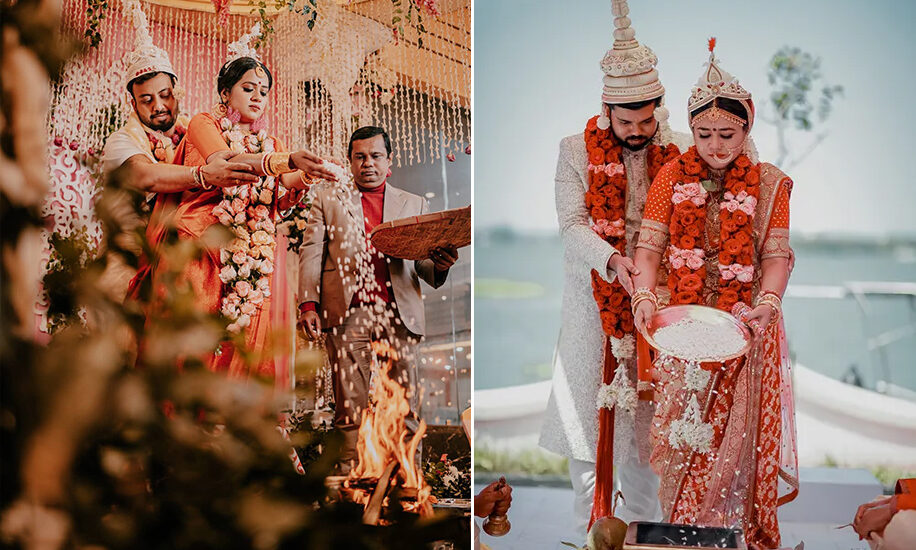Introduction
Planning a wedding is a beautiful journey filled with excitement, dreams, and traditions. When it comes to a Bengali wedding, this journey takes on an even richer hue, blending centuries-old customs with contemporary touches. Bengali weddings are known for their vibrancy, cultural depth, and an array of rituals that celebrate the union of two souls and their families. From the pre-wedding ceremonies to the grand reception, each event is meticulously planned and infused with meaning. This guide, “Planning a Bengali Wedding: Traditions and Tips,” aims to walk you through the enchanting world of Bengali nuptials, offering insights into traditional practices while providing practical advice for modern-day planning. Whether you are a bride, groom, family member, or a wedding planner, this comprehensive guide will help you navigate the intricate and joyous process of organizing a Bengali wedding, ensuring that every moment is as magical as the love story it celebrates.
History of Bengali Weddings
Bengali weddings, deeply rooted in the rich cultural tapestry of Bengal, reflect a blend of traditional Hindu customs and regional uniqueness. Historically, Bengali weddings, known as ‘biye’, have evolved from simple, community-centric events to elaborate celebrations. They typically commence with rituals like the ‘Aiburo Bhaat,’ a feast symbolizing the end of bachelorhood, followed by ‘Gaye Holud,’ where turmeric paste is applied to the bride and groom for glowing skin. The main ceremony, ‘Bor Jatri,’ involves the groom’s procession to the bride’s house, culminating in the ‘Saat Paak,’ where the bride is carried around the groom seven times by her brothers. This is followed by the ‘Shubho Drishti,’ where the couple’s eyes meet for the first time. Post-wedding rituals, such as ‘Bashi Biye,’ where the bride and groom revisit the vows on the next day, and ‘Bou Bhaat,’ the formal introduction of the bride to the groom’s family, underscore the significance of family and community. Bengali weddings, with their vibrant customs, rituals, and emphasis on mutual respect and family bonding, offer a profound glimpse into the historical and cultural ethos of Bengal, celebrating not just the union of two individuals, but the coming together of two families and communities.
Pre-Wedding Rituals

Aiburobhat (Bachelor/Bachelorette Feast)
Aiburobhat is a feast thrown for the bride and groom before their wedding, symbolizing the last meal as a bachelor or bachelorette. Friends and family gather to celebrate, offering their blessings and sharing a meal that includes the individual’s favorite dishes.
Ashirbaad (Blessings Ceremony)
In the Ashirbaad ceremony, the elders of the family bless the bride and groom. This ritual involves applying a touch of rice and durba (a type of grass) to the couple’s heads, symbolizing prosperity and long life. Gifts and jewelry are also given to the bride and groom during this ceremony.
Gaye Holud (Haldi Ceremony)
Gaye Holud is a joyous occasion where turmeric paste is applied to the bride and groom by their friends and family. This is believed to purify and beautify them before the wedding. The event is filled with music, dance, and laughter, making it one of the most enjoyable pre-wedding rituals.
Key Wedding Rituals
Bor Jatri (Groom’s Procession)
The Bor Jatri is the groom’s procession to the wedding venue, often accompanied by friends and family, music, and dancing. This lively procession symbolizes the groom’s journey to bring his bride home.
Saat Paak (Seven Circumambulations)
In Saat Paak, the bride is seated on a wooden platform (piri) and is carried by her brothers around the groom seven times. This symbolizes the seven vows and promises they make to each other, marking the beginning of their marital journey.
Mala Bodol (Exchanging of Garlands)
Mala Bodol is the exchange of flower garlands between the bride and groom, signifying their acceptance of each other. This ritual is usually conducted amidst much cheering and joy from the gathered family and friends.
Subho Drishti (First Glance)
Subho Drishti is the moment when the bride and groom exchange their first glance, symbolizing the start of their journey together. The bride removes the betel leaves covering her face, and they look at each other amidst traditional songs and blessings.
Post-Wedding Rituals

Bidaai (Farewell)
Bidaai is an emotional farewell where the bride leaves her parental home to start a new life with her husband. This ceremony signifies the bride’s transition from her family to her husband’s family, often marked by tears and heartfelt goodbyes.
Bou Bhaat (Reception)
Bou Bhaat is the reception hosted by the groom’s family to introduce the bride to their relatives and friends. It involves a grand feast and various cultural performances, symbolizing the bride’s official welcome into the groom’s family.
Kal Ratri (First Night Ritual)
Kal Ratri, or the night of consummation, is traditionally observed by keeping the bride and groom apart on their first night to ward off evil spirits. The couple is united the following day, marking the beginning of their conjugal life.
Traditional Attire
Bride’s Attire
The bride typically wears a red or maroon Benarasi saree, adorned with gold embroidery. Red symbolizes prosperity and marital bliss. Accompanied by traditional jewelry, the bride’s look is completed with a Mukut (headgear) and Alta (red dye) on her hands and feet.
Groom’s Attire
The groom usually dons a dhoti and kurta, often made of silk, and a topor (traditional conical headgear). The groom’s attire, although simpler than the bride’s, is equally significant and symbolizes traditional Bengali values.
Accessories and Significance
Both the bride and groom wear various accessories, each symbolizing different aspects of their union. For example, the bride’s shakha pola (conch shell bangles) represents marital status and prosperity, while the groom’s rings and chains often signify commitment and stability.
Culinary Delights
Traditional Wedding Menu
Bengali weddings are known for their sumptuous feasts, featuring a variety of traditional dishes. The menu usually includes fish (a must in any Bengali celebration), meat, rice, lentils, and a plethora of vegetable dishes.
Popular Bengali Dishes
Signature dishes like Macher Jhol (fish curry), Kosha Mangsho (spicy mutton curry), and Shorshe Ilish (hilsa fish in mustard sauce) are often served. Each dish has its own cultural significance and is prepared with great care.
Sweets and Desserts
No Bengali wedding is complete without a lavish spread of sweets. Favorites include Rosogolla, Sandesh, and Mishti Doi (sweetened yogurt). These desserts are not just treats but a celebration of the region’s rich culinary heritage.
Music and Dance
Traditional Music
Music is an integral part of Bengali weddings, with traditional songs like ‘Bashor Ghor’ and ‘Biyer Gaan’ setting the mood. These songs, often sung by family members, add a personal touch to the celebrations.
Popular Dance Forms
Dance performances, especially by the younger members of the family, are common. Traditional dance forms like the Dhunuchi Naach (dance with incense burners) and modern Bollywood numbers both find a place in the festivities.
Modern Influences
While traditional music and dance dominate, modern influences like DJ nights and choreographed performances are also becoming popular, blending the old with the new.
Decor and Themes
Traditional Decor Elements
Traditional decor elements include marigold flowers, banana trees, and alpana (decorative patterns drawn with rice flour). These elements add an authentic touch to the wedding venue, making it vibrant and festive.
Modern Decor Trends
Modern decor trends incorporate themes like vintage, floral, and minimalistic styles. These themes often blend traditional elements with contemporary aesthetics, providing a unique look to the wedding.
Combining Tradition with Contemporary Styles
Many couples opt to combine traditional and contemporary styles, using classic decor with modern twists. This combination not only respects cultural heritage but also caters to modern tastes.
Invitations and Guest Management
Designing Traditional Invites
Traditional Bengali wedding invitations are often elaborate, featuring intricate designs and auspicious symbols like the lotus and the conch shell. These designs reflect the cultural richness and significance of the wedding.
Managing Guest Lists
Managing guest lists is crucial for a smooth wedding. It involves categorizing guests into various groups, ensuring that everyone is accommodated, and sending out invites well in advance.
Etiquette and Protocol
Understanding and following the etiquette and protocol for inviting guests is essential. This includes respecting elders, ensuring personal touches in invitations, and managing RSVPs efficiently.
Budget Planning
Estimating Costs
Estimating costs accurately is vital for budget planning. This includes considering all expenses, from venue booking to catering and decorations, ensuring that nothing is overlooked.
Saving Tips
To save costs, consider options like off-season bookings, local vendors, and DIY decor. It’s also wise to prioritize expenses, focusing on what is most important for the couple and their families.
Balancing Tradition and Affordability
Balancing tradition with affordability can be challenging but achievable. Opt for simpler versions of elaborate rituals, or combine certain ceremonies to save on costs while still honoring traditions.
Choosing the Venue
Traditional Venues
Traditional venues like temples, community halls, and family homes offer an authentic setting for Bengali weddings. These venues often come with the added benefit of familiarity and sentimental value.
Modern Options
Modern options include banquet halls, hotels, and resorts. These venues provide more facilities and conveniences, catering to the needs of large gatherings and modern amenities.
Factors to Consider
When choosing a venue, consider factors like location, capacity, facilities, and cost. Ensure the venue aligns with the wedding theme and can comfortably accommodate all guests.
Photography and Videography
Capturing Traditions
Capturing the rich traditions of a Bengali wedding through photography and videography is crucial. This includes key moments like the Saat Paak, Mala Bodol, and Bidaai, ensuring that these memories are preserved.
Choosing the Right Professionals
Choosing the right photographers and videographers is essential for capturing the essence of the wedding. Look for professionals with experience in documenting traditional weddings and who understand the significance of each ritual.
Modern Trends in Wedding Photography
Modern trends like candid photography, pre-wedding shoots, and cinematic videography are becoming popular. These trends add a contemporary touch to the wedding album, making it more dynamic and engaging.
Professional Help
Role of Wedding Planners
Wedding planners play a significant role in organizing a Bengali wedding. They help with everything from budgeting and vendor selection to coordinating the ceremonies and managing the timeline.
Choosing the Right Vendors
Selecting the right vendors is crucial for a successful wedding. This includes caterers, decorators, photographers, and entertainment providers. Ensure that each vendor is reliable and has good reviews.
Benefits of Professional Assistance
Professional assistance can ease the stress of wedding planning, allowing the couple and their families to enjoy the celebrations. Wedding planners bring expertise and efficiency, ensuring that everything runs smoothly.
Conclusion
Planning a Bengali wedding is a vibrant and deeply cultural experience, blending time-honored traditions with personal touches to create an unforgettable celebration. From the intricate rituals like Aiburo Bhaat and Gaye Holud to the elegant attire and sumptuous cuisine, every aspect of a Bengali wedding is rich with meaning and significance.
By understanding and respecting these traditions, couples can ensure that their wedding not only honors their heritage but also reflects their unique love story. The key to a successful Bengali wedding lies in meticulous planning, clear communication, and a touch of creativity. Whether you opt for a traditional ceremony or a fusion of modern elements with classic customs, the ultimate goal is to create a joyous occasion that brings families together and marks the beginning of a new journey.
As you embark on this planning process, remember to savor each moment and cherish the memories you create along the way. With thoughtful preparation and a heartfelt approach, your Bengali wedding will be a beautiful and meaningful celebration that you and your loved ones will treasure forever.









